Up to 1 billion birds die from window strikes in the United States each year, a startling statistic that highlights the widespread issue of birds colliding with windows. While window strikes can be fatal, even if the bird initially appears only temporarily stunned and flies away, the reasons behind these collisions may hold deeper spiritual and symbolic meanings for some.
The reflections and transparency of windows can confuse birds, leading them to mistake the glass for an open pathway or perceive reflections as real objects. Additionally, artificial lighting at night can divert nocturnal migrating birds off course, causing them to collide with lighted structures. These factors contribute to the alarming frequency of window strikes, which can have significant implications in the realm of bird behavior and superstitions.
Key Takeaways
- Window strikes can be a common and deadly problem for birds, with up to 1 billion deaths annually in the US.
- Reflections, transparency, and artificial lighting at night all contribute to birds mistaking windows for open pathways or colliding with lighted structures.
- The spiritual and symbolic interpretations of birds hitting windows vary across cultures, often signifying messages, omens, or life transitions.
- Understanding the causes and potential meanings behind window strikes can help individuals respond appropriately and take steps to protect birds.
- Addressing the problem of window collisions is an important conservation effort that can save countless bird lives.
Causes of Birds Hitting Windows
Bird behavior is a fascinating aspect of the natural world, and understanding the reasons behind why birds collide with windows is crucial for protecting these feathered creatures. Two primary factors contribute to this issue: reflections and transparent surfaces, as well as artificial lighting at night.
Reflections and Transparent Surfaces
Birds often see the reflected vegetation or sky in windows and attempt to fly through what they perceive as open space. This misunderstanding can lead to disastrous consequences, as birds crash into the seemingly transparent surfaces. In fact, at least half of the birds that hit windows die from their injuries or are killed by other animals while stunned and unable to protect themselves.
Artificial Lighting at Night
Another significant cause of bird strikes is the presence of artificial lighting at night. Nocturnal migrating birds can be drawn off course by the bright lights, leading them to collide with lighted structures. The disorienting effects of these lights confuse the birds, causing them to mill about and sometimes collide with the building or with each other.
Addressing these underlying causes is crucial for protecting birds from window collisions. Strategies such as applying tape strips, moving bird feeders and baths, using modern dual-pane windows with bug screens, and positioning angled glass downward can all help make windows more visible and reduce the risk of bird strikes.
“Prevention measures like treating glass to make it visible to birds, reducing light pollution, and using bird-safe building designs can significantly decrease the occurrence of birds hitting windows.”
Scope of the Problem
The magnitude of the window collision crisis facing birds in the United States is staggering. According to recent estimates, up to 1 billion birds may die annually from striking glass surfaces, including homes, buildings, and other structures. This alarming statistic underscores the sheer scale of the problem and the urgent need for effective solutions to protect bird populations.
The high rate of window collisions can be attributed to the proliferation of reflective and transparent glass surfaces in modern architecture, combined with the way birds perceive their environment. As birds fly, they often mistake reflections and transparent windows for open airspace, leading them to collide with the glass at high speeds. This tragic outcome not only impacts individual birds but also contributes to the long-term decline of many bird species.
Billion Birds Die from Window Strikes Annually
Estimates suggest that between 100 million to 1 billion birds are killed each year in the United States due to window collisions. This staggering figure highlights the widespread and devastating impact of this issue on bird conservation efforts. The problem is particularly acute during peak migration periods, when adult birds and their offspring are on the move, making them more vulnerable to these fatal encounters with glass.
Resident birds, especially juveniles, also face a high risk of colliding with windows, particularly during the summer months. Collisions can occur year-round, especially near bird feeders and baths, further contributing to the troubling toll on local bird populations.
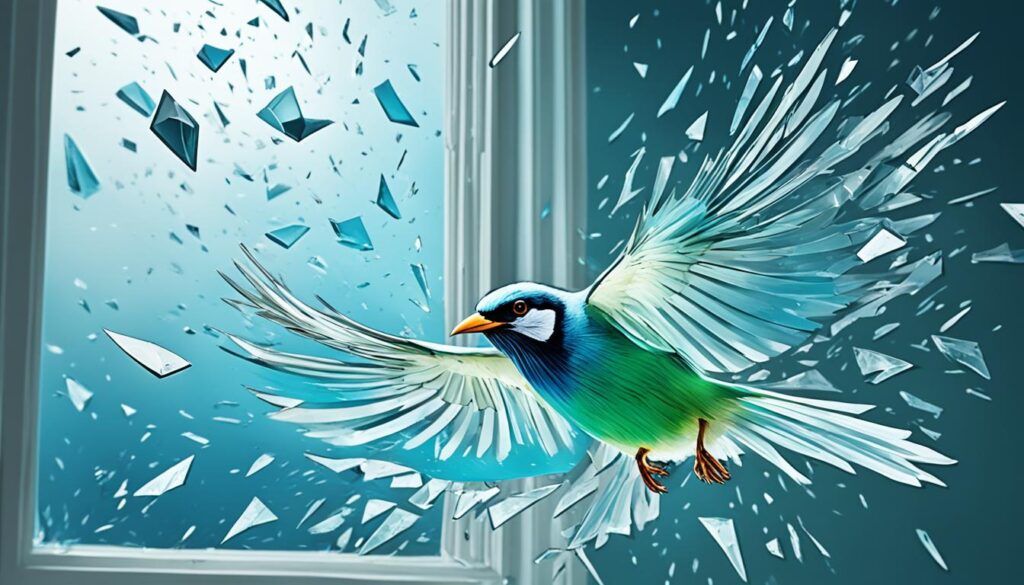
“The sheer number of windows, combined with the way birds perceive reflections and transparent surfaces, contributes to this huge annual toll on bird populations.”
Addressing the window collision crisis is crucial for the long-term health and survival of birds in the United States. By raising awareness, implementing effective mitigation strategies, and promoting bird-friendly building design, we can work to reduce the devastating impact of this issue and safeguard our feathered friends for generations to come.
Types of Window Collisions
Window collisions pose a significant threat to birds, with an estimated 365 million to 1 billion bird deaths occurring each year due to these incidents in the United States alone. Understanding the two main types of window collisions, daytime and nighttime, is crucial in addressing this pressing issue.
Daytime Collisions
Daytime collisions often occur when birds see reflections of vegetation or transparency through the glass, mistakenly perceiving it as a safe passage. These birds may crash into windows while chasing prey, fleeing predators, or simply flying across their natural habitat. The reflections on the glass can be particularly deceiving, leading birds to collide with the unexpected barrier.
Nighttime Collisions
Nighttime collisions, on the other hand, primarily involve nocturnal migrating birds, including many songbird species. These birds are attracted to and disoriented by artificial lighting, which can divert them from their original flight paths and cause them to collide with lighted structures. The bright lights can confuse and disorient the birds, leading to tragic window strikes.
Regardless of the time of day, window collisions can have devastating consequences for bird populations. Addressing the underlying causes and implementing effective solutions is crucial in protecting these vital members of our ecosystems.
“Birds of all sizes travel at speeds high enough that a window collision almost always results in fatality.”
Territoriality and Bird Reflection Attacks
In addition to the reflections and transparent surfaces, birds sometimes see their own reflection in a window and mistakenly attack it, perceiving it as a rival trying to encroach on their territory. This behavior is most common during the spring nesting season, when birds like mockingbirds, robins, and cardinals are highly territorial.
Cardinals, for example, may become obsessed with their window reflection, attacking it for weeks on end as they defend their nest site. Similarly, other highly territorial species like robins, corvids, and peacocks may also mistake their reflection for another bird, leading to aggressive attacks on the windows.
According to Birds & Blooms, the #1 bird and garden magazine in North America, this territorial behavior is driven by the need to protect essential nesting areas and the resources within them. During the breeding season, birds dedicate significant time and energy to defending their territory from perceived threats, which can unfortunately include their own reflection.
“Cardinals, like many other birds, defend a territory during the nesting season. This can lead them to become obsessed with phantom rivals, attacking their own reflections on windows for weeks.” – Kenn and Kimberly Kaufman, birding experts
While this behavior can be frustrating for homeowners, it is usually not a threat to the bird’s survival. However, the repeated strikes against the window can result in injuries such as broken bones, beaks, and head or spinal trauma. To prevent these bird strikes and protect the birds, experts recommend strategies like blocking the window, using colorful paints, or applying window-safe products.
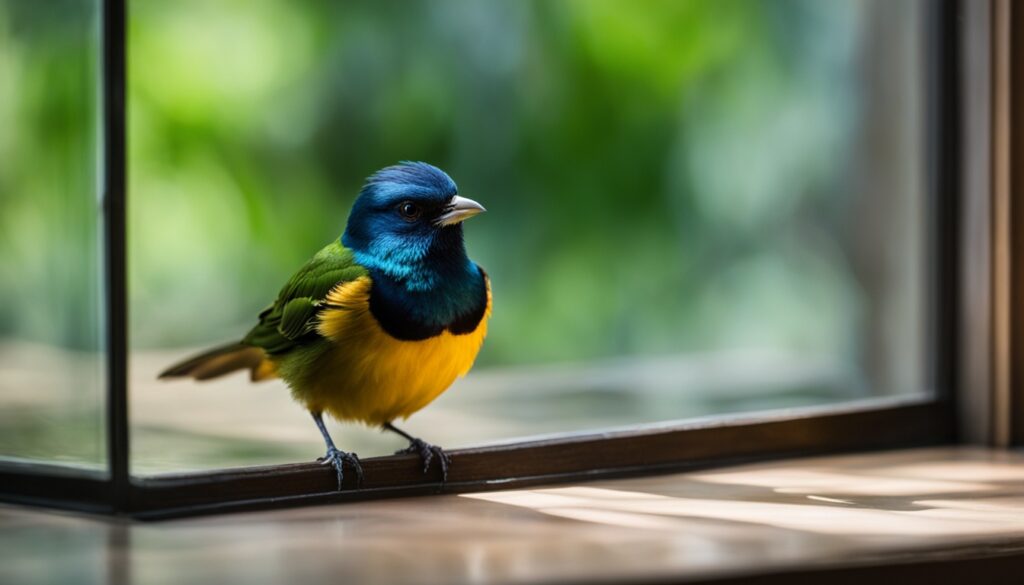
By understanding the role of territoriality in bird behavior and window collisions, homeowners can take proactive steps to create a safer environment for their feathered neighbors.
Identifying Dangerous Windows
Protecting birds from window collisions starts with identifying the most hazardous windows in your home or office. Ornithologists estimate that up to 100 million birds are killed each year by collisions with windows. Certain window types and placements pose a greater threat to our feathered friends.
Large picture windows, particularly those that offer a clear view of the outdoors, can be a magnet for birds. Paired windows at right angles to each other can also create confusion, as birds may perceive the space between the windows as a clear flight path. Windows with feeders or bird baths placed outside are especially dangerous, as they attract birds to the area.
To assess the risk of your windows, step outside and view them from a bird’s perspective. If the windows reflect the surrounding landscape, sky, or vegetation, they are likely to pose a threat. Birds see these reflections as a continuation of their habitat, not a barrier.
Nocturnal migrants, such as orioles, tanagers, and warblers, are particularly at risk from lighted high-rise windows at night. The bright lights can disorient these birds, leading to fatal collisions.
By identifying the most hazardous windows in your home or office, you can take proactive steps to protect birds and prevent window collisions and bird strikes. This is an important first step in protecting birds from windows.
Solutions to Prevent Window Strikes
Protecting birds from window collisions is a crucial concern, with an estimated 365 million to 1 billion birds colliding with buildings annually in the United States. Fortunately, there are several effective solutions available to prevent these tragic incidents and promote bird-friendly building design.
Window Markings and Decals
One of the most accessible and widely-used solutions is the application of window markings or decals. These visual cues help birds recognize the presence of glass, deterring them from attempting to fly through. Experts recommend using high-contrast patterns that cover the entire window surface, with no gaps larger than 5 cm by 5 cm (2 inches by 2 inches). Products like BirdTape and Feather Friendly DIY Tape have been noted for their effectiveness when installed correctly.
External Screens and Netting
Installing external screens or netting can also create a physical barrier between birds and the glass, reducing the risk of collisions. Exterior window screens, such as Bird Screens, provide a flexible solution that can be easily added to existing windows. These screens create a protective layer that helps birds recognize the presence of the window and avoid striking it.
Window Films and Shutters
Another effective approach is the use of window films or shutters. Frosted or opaque glass with patterns that meet FLAP Canada’s Guidelines for Visual Markers can effectively prevent bird strikes. Additionally, temporary solutions like patterns made with tempera paint, soap, or whitewashing can serve as quick fixes, though they may require frequent reapplication.
By implementing these solutions, homeowners and building owners can significantly reduce the number of bird collisions and contribute to the conservation of our feathered friends. Integrating bird-friendly design features into new construction, such as strategically placing bird feeders and minimizing reflective surfaces, can also help protect birds and create a more sustainable built environment.

“Moving bird-feeders closer to windows can reduce the likelihood of birds building up enough momentum to injure themselves if they accidentally fly into the windows.”
Ultimately, a combination of strategies, including visual cues, physical barriers, and design considerations, can effectively prevent window strikes and contribute to the conservation of bird populations.
Lights Out Initiatives
As the issue of protecting birds from windows gains more attention, several cities across the United States have implemented “Lights Out” initiatives to address the problem of artificial light at night attracting and disorienting migrating birds. These innovative programs have proven effective in reducing the number of bird deaths caused by window strikes.
Studies have shown that up to 60% of birds colliding with windows occur in commercial buildings, particularly during the peak migration seasons. Urban areas can see bird strike rates as high as 35 incidents per building each year. Interestingly, high-rise structures tend to pose a greater threat to birds compared to residential buildings, with some studies reporting a 10-fold increase in collision events.
“Implementing Lights Out Initiatives can significantly reduce bird-window collisions, with some cities reporting a 60-80% decrease in fatalities after the programs were introduced.”
By turning off non-essential lighting at night and ensuring that exterior lights are downward-facing, these initiatives help prevent migratory birds from being drawn off course and becoming vulnerable to deadly window strikes. The effectiveness of Lights Out programs has been demonstrated, with some cities reporting a 60-80% decrease in bird fatalities after their implementation.
In Chicago, for example, the city’s Lights Out Chicago program has seen a significant impact, with over 70% of commercial properties participating and a reported 80% reduction in bird collisions. Similarly, New York City’s Lights Out New York initiative has been widely adopted, with a growing number of buildings joining the effort to protect bird conservation.
By combining Lights Out Initiatives with other solutions, such as bird-friendly building design and the use of window markings or films, the issue of window strikes can be effectively addressed, reducing the devastating impact on bird populations and promoting sustainable coexistence between humans and wildlife.
what does it mean when birds hit your window
When a bird unexpectedly collides with your window, it can be a startling and concerning sight. While some may interpret these incidents as omens or signs, the reality is often more straightforward. Window strikes are a widespread problem that poses a serious threat to bird populations worldwide.
The reasons behind these collisions are primarily due to the nature of glass and reflective surfaces. Birds often see the sky or surrounding environment reflected in the window, mistaking it for an open passageway. This can lead to disorientation and tragic consequences as the birds collide with the seemingly invisible barrier.
“I’ve had birds hit my window, and it’s always a shocking and sad experience. It’s important to remember that these collisions are not a sign of anything supernatural, but rather a result of the birds’ natural behavior and the hazards posed by modern architecture.”
While some cultures and traditions may associate bird-window encounters with superstitions or omens, the scientific explanation is more straightforward. These incidents are not a harbinger of good or bad luck, but rather a testament to the significant challenges birds face in our built environment.
- Window strikes are not a sign of supernatural occurrences or divine messages.
- They are a common occurrence caused by the reflection and transparency of glass, which can confuse birds.
- Addressing the underlying causes of these collisions, such as through the use of bird-friendly window treatments, can help save countless avian lives.
By understanding the true nature of these incidents, we can approach them with empathy and take practical steps to mitigate the risk to our feathered friends. Ultimately, the collision of a bird with a window is a reminder of the need to create a more sustainable and bird-friendly world.
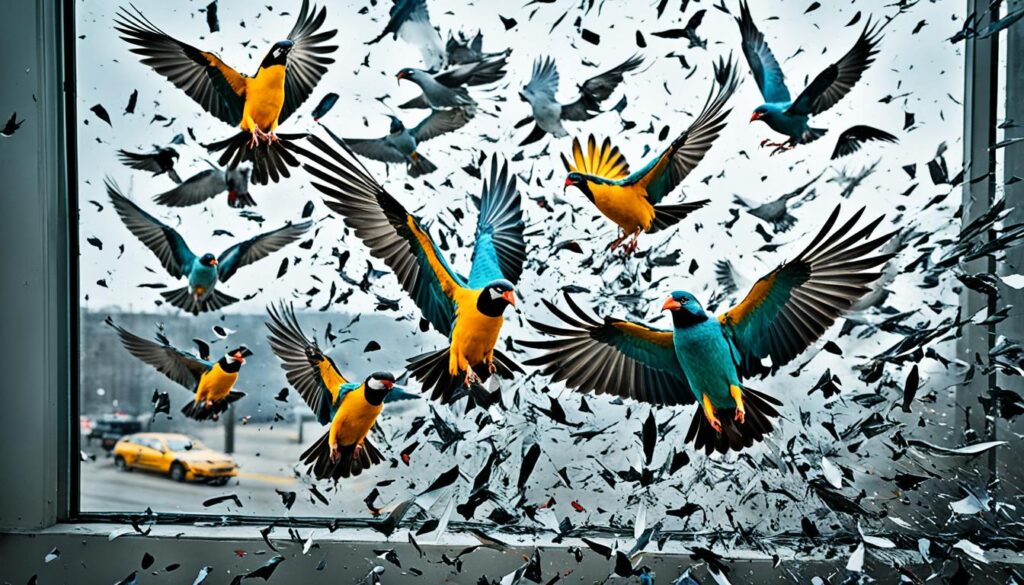
Helping an Injured Bird
When a bird collides with a window, the outcome can be devastating. However, with prompt and proper care, some injured birds can be saved. If you encounter an injured bird after a window strike, it’s crucial to act quickly to provide the necessary assistance and get the bird to a wildlife rehabilitator as soon as possible.
Capture and Contain
The first step in helping an injured bird is to safely capture and contain it. Approach the bird slowly and calmly, avoiding sudden movements that may further stress the animal. Gently place a towel or box over the bird, then slide a piece of cardboard or another rigid surface underneath to scoop it up. Be mindful of the bird’s fragile condition and handle it as little as possible.
Once the bird is contained, keep it in a quiet, dark, and well-ventilated area, such as a cardboard box with air holes. Avoid providing food or water, as the bird may be in shock and offering sustenance could do more harm than good.
Transport to Wildlife Rehabilitator
The next crucial step is to transport the injured bird to a licensed wildlife rehabilitation center or veterinarian as soon as possible. These professionals have the training and resources to properly assess the bird’s injuries and provide the necessary medical care. Helping injured birds and promoting bird conservation efforts are vital to ensuring the well-being of local bird populations.
Be sure to handle the bird gently and minimize its stress during transport. Keep the container covered to reduce the bird’s exposure to loud noises or bright lights. Once at the rehabilitation facility, the staff will be able to provide the appropriate treatment and care to give the injured bird the best chance of recovery.
“Every bird that hits a window represents a potential loss to the local ecosystem. By taking action to help injured birds, we can make a real difference in preserving these important members of our natural communities.”
Prompt and compassionate action can make all the difference in the survival of an injured bird. By following the proper steps to capture, contain, and transport the bird to a wildlife rehabilitator, you can play a vital role in helping injured birds and supporting bird conservation efforts in your area.
Territorial Bird Behavior Solutions
While implementing various solutions to prevent birds from colliding with windows, it’s crucial to address the underlying issue of territorial bird behavior. Many species, such as American Robins, Northern Cardinals, and Chipping Sparrows, are known to aggressively attack their own reflections in windows, mistaking them for rival birds invading their territory.
This territorial aggression is typically most prevalent during the breeding season, starting as early as February or March and potentially lasting until August. Birds may repeatedly strike the windows, causing damage and putting themselves at risk of injury or even death.
To mitigate this problem, a simple yet effective solution is to place a mirror or car side mirror away from the windows. This allows the bird to direct its territorial behavior towards the “rival” reflection, rather than repeatedly striking the actual window. This approach can significantly reduce the number of bird-window collisions caused by territorial disputes.
Other temporary measures, such as covering the window with plastic sheets, shower curtains, or non-reflective cellophane, can also help mute reflections and deter birds from attacking. Applying soap to the outside surface of the window during nesting season can create a matte finish and reduce the reflective glare that attracts birds.
For a more long-lasting solution, installing perforated window film or exterior window screens can effectively prevent bird-window collisions while still allowing natural light to enter the building. These bird-friendly solutions not only protect the birds but also maintain the aesthetic appeal of the property.
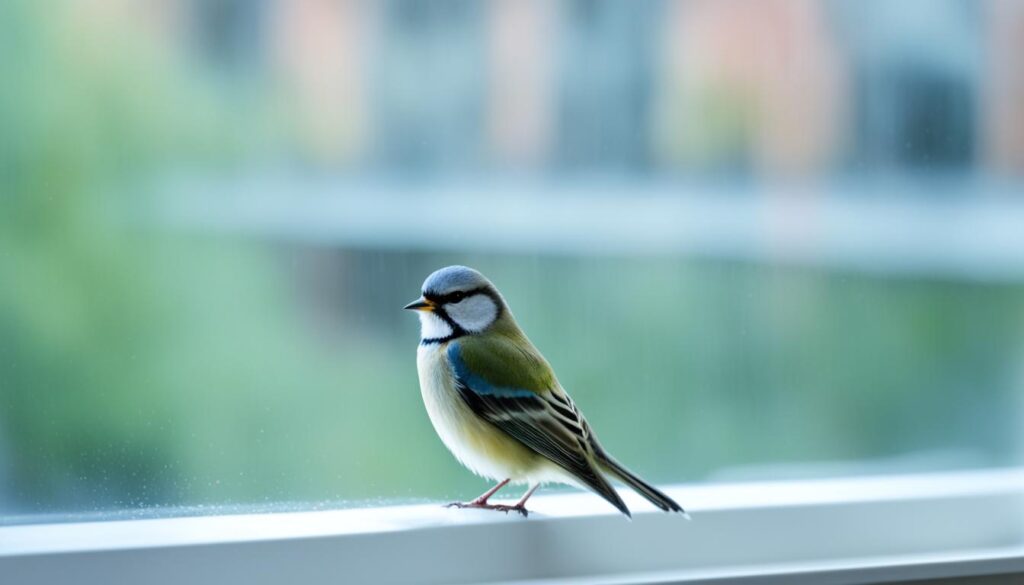
“Addressing territorial bird behavior is a crucial aspect of protecting birds from window strikes. By providing alternative targets for their aggression, we can significantly reduce the risk of injury and fatality.”
Remember, the goal is to find a balance between human needs and bird conservation. By understanding and addressing the root causes of bird-window collisions, we can create a safer environment for both birds and the people who share their spaces.
Bird-Friendly Building Design
Designing buildings that are bird-friendly is crucial in protecting avian populations from the devastating impact of window collisions. Studies show that the frequency of birds hitting windows is a common occurrence, with strategies to prevent these collisions being essential in mitigating the impact on bird populations.
One effective approach is to install windows with screens on the entire outside of the glass. This helps create a visual barrier that birds can easily detect, reducing the risk of accidental strikes. Another option is to use one-way transparent films that appear opaque from the outside, making it clear to birds that the surface is not open airspace.
- Incorporating external sun shades or awnings can also block reflections, further reducing the chances of birds mistaking windows for open flight paths.
- Strategically placing potted plants or other visual cues near windows can alert birds to the presence of the glass barrier.
By implementing these bird-friendly building design features, architects and developers can significantly reduce the risk of bird collisions and contribute to the conservation of avian species. Tracking the effectiveness of these measures through comparative analysis and data collection is crucial to refining the guidelines for protecting birds from windows.
“Designing buildings that are bird-friendly is not only an ethical responsibility but also a practical solution to a widespread problem. By incorporating these strategies, we can create safer environments for our feathered friends.”
As the awareness of the importance of bird-friendly building design continues to grow, architects and developers have a unique opportunity to make a positive impact on local bird populations. By adopting these best practices, we can work towards a future where buildings coexist harmoniously with the natural world, benefiting both birds and the human community.
Citizen Science and Conservation Efforts
In the fight against the alarming issue of birds hitting windows, citizen science and conservation initiatives are playing a crucial role. These collaborative efforts engage the public in monitoring, data collection, and advocacy for policies that protect our feathered friends.
One such initiative is the Fatal Light Awareness Program (FLAP), which works tirelessly to raise awareness and provide resources for making homes and buildings more bird-friendly. Through their citizen science projects, FLAP encourages people to report incidents of dead or injured birds, contributing invaluable data to guide research and conservation efforts.
Another groundbreaking project is the BirdCast program, which utilizes real-time migration data to track bird movements and alert the public to potential collision risks. By empowering citizens to be informed and proactive, these initiatives are making a tangible impact on protecting birds from window strikes.
“As many as a billion birds die in the U.S. each year by flying into windows and glass walls.”
The scope of the problem is staggering, with estimates suggesting that 365 million to nearly 1 billion birds are killed by window collisions annually in the United States alone. However, the power of citizen science is evident, as more than half of the data relied upon for a 2014 study on bird-window collisions came from citizen-science projects around North America.
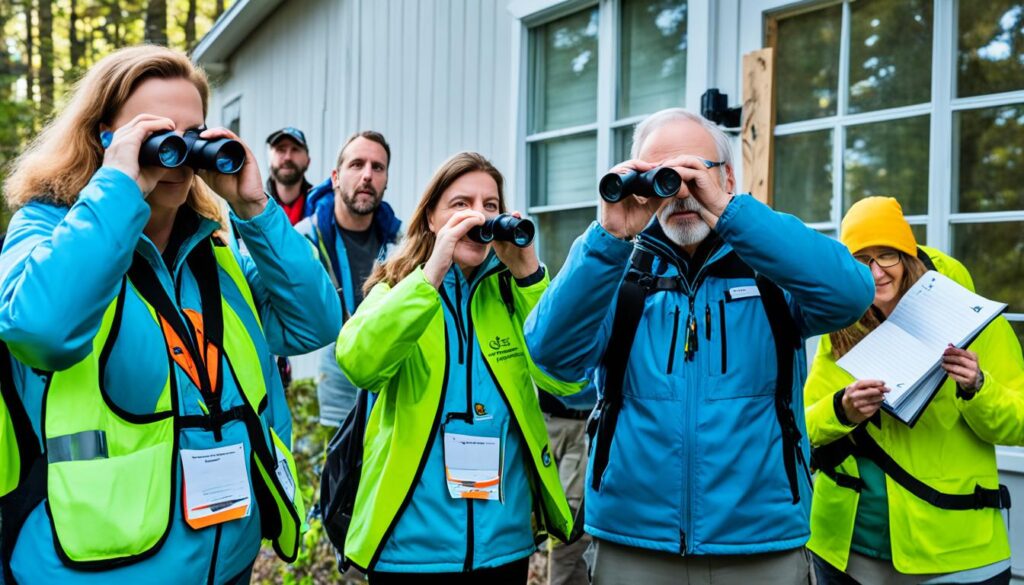
From the Lights Out initiatives in cities like Nashville and Colorado to the growing popularity of bird-friendly window products like those offered by Feather Friendly, the tide is turning. Grassroots efforts and the collective power of concerned citizens are driving real change in the fight to protect our avian populations.
By participating in citizen science projects, advocating for bird-friendly policies, and adopting simple solutions to make our built environments more bird-safe, we can all contribute to the conservation of these valuable and vulnerable species. Together, we can make a meaningful difference in the ongoing battle to protect birds from the threat of window collisions.
Conclusion
In conclusion, the factual data highlights the significant problem of window collisions, with up to 1 billion avian deaths occurring annually in the United States. The causes range from reflections, transparent surfaces, and artificial lighting at night that can divert migrating birds. While the issue is severe, there are effective solutions available to reduce this tragic toll on bird populations.
Homeowners and policymakers can play a vital role in addressing window collisions and promoting bird conservation. Practical remedies such as applying window markings, installing screens or netting, and incorporating bird-friendly design features into new construction can significantly mitigate the problem. By addressing the underlying causes and implementing these practical solutions, we can work towards reducing the number of window strikes and protecting birds from this threat.
The spiritual and cultural interpretations surrounding birds hitting windows are diverse, with various beliefs and traditions influencing perceptions of these occurrences. However, the focus should remain on the factual data and practical steps that can be taken to protect birds and their habitats. By combining scientific understanding with a reverence for the natural world, we can work towards a future where birds and humans coexist in harmony, with window collisions becoming a thing of the past.
FAQ
What does it mean when birds hit your window?
According to the factual data, birds often crash into windows because they see reflections of vegetation or see through the glass to potted plants or vegetation on the other side. This is a common problem, with up to 1 billion birds dying from window strikes in the U.S. each year.
What are the causes of birds hitting windows?
The factual data explains that reflections and transparent surfaces are a major cause of birds crashing into windows. Birds see the reflected vegetation or sky and attempt to fly through what they think is open space. Additionally, artificial lighting at night can divert nocturnal migrating birds off course, leading them to collide with lighted structures.
What is the scope of the bird-window collision problem?
According to the first source, up to 1 billion birds die from window strikes in the U.S. each year. This staggering figure highlights the massive scale of the problem and the need for solutions to prevent these unnecessary bird deaths.
What are the different types of window collisions?
The factual data outlines two main types of window collisions: daytime and nighttime. Daytime collisions occur when birds crash into windows because they see reflections of vegetation or see through the glass to potted plants or vegetation on the other side. Nighttime collisions happen when nocturnal migrating birds, including most songbirds, fly into lighted windows.
Why do some birds attack their own reflections in windows?
The factual data explains that birds sometimes see their own reflection in a window and attack it, mistaking it for a rival trying to usurp their territory. This behavior is most common in the spring when territoriality is high, particularly among species like mockingbirds, robins, and cardinals.
How can I identify dangerous windows that are more likely to attract bird collisions?
The factual data provides guidance on identifying dangerous windows, including large picture windows, paired windows at right angles to each other, and windows with feeders outside. Homeowners can go outside and look at their windows from a bird’s perspective to see if they reflect branches, sky, or vegetation.
What are some solutions to prevent bird collisions with windows?
The factual data outlines several effective solutions, including applying window markings or decals, installing external screens or netting, using window films or shutters, and incorporating bird-friendly design features into new construction.
What are “Lights Out” initiatives, and how do they help prevent bird collisions?
The factual data highlights the growing “Lights Out” initiatives in several U.S. cities, which aim to reduce the problem of artificial light at night attracting and disorienting migrating birds. By turning off non-essential lights and installing downward-facing lighting, these initiatives can help prevent birds from being drawn off course and becoming vulnerable to window collisions.
What should I do if I find an injured bird after a window collision?
The factual data provides guidance on what to do if a bird is found injured after colliding with a window. The key steps are to carefully capture and contain the bird, then transport it to a local wildlife rehabilitation facility as soon as possible.
How can I address the problem of birds attacking their own reflections in windows?
The factual data suggests using a mirror or car side mirror placed away from the windows to allow the bird to direct its territorial aggression towards the “rival” reflection, rather than repeatedly striking the actual window.
What are some bird-friendly design features for new construction or window replacements?
The factual data emphasizes the importance of incorporating bird-friendly design features, such as installing windows with screens on the entire outside of the glass, using one-way transparent films, and incorporating external sun shades or awnings to block reflections.
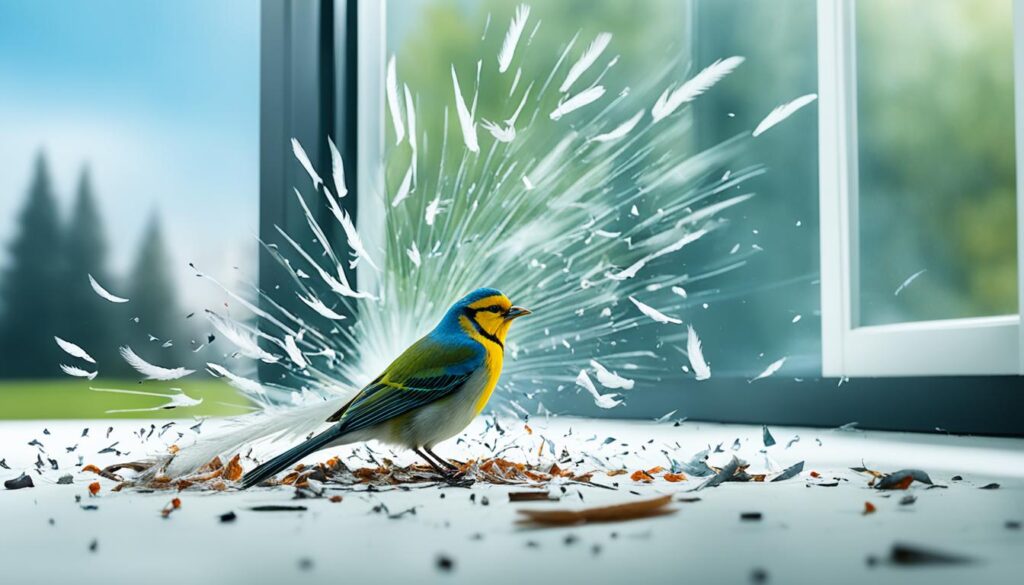

Muchas gracias. ?Como puedo iniciar sesion?
I visited various web sites however the audio quality for audio songs existing at this web site is
genuinely superb.
my homepage nordvpn coupons inspiresensation, 92url.com,
nordvpn special Coupon code 2025 350fairfax
I am curious to find out what blog platform you are utilizing?
I’m experiencing some small security issues with my latest blog and
I’d like to find something more safeguarded. Do you have any
solutions?
Thanks for discussing your ideas. Another thing is that individuals have a choice between federal student loan along with a private student loan where its easier to go for student loan debt consolidation loan than in the federal student loan.